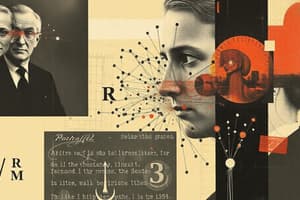Podcast
Questions and Answers
What does a positive correlation indicate about two variables?
What does a positive correlation indicate about two variables?
- One variable decreases while the other increases.
- Both variables move in the same direction. (correct)
- One variable has no impact on the other.
- The two variables are completely unrelated.
In an experiment, which term describes the group that does not receive the test variable?
In an experiment, which term describes the group that does not receive the test variable?
- Confounding variable group
- Control group (correct)
- Experimental group
- Independent variable group
What is the primary purpose of random assignment in experimental research?
What is the primary purpose of random assignment in experimental research?
- To manipulate the independent variable effectively.
- To ensure that all participants have the same background.
- To minimize preexisting differences between groups. (correct)
- To influence the dependent variable outcomes.
What is an operational definition?
What is an operational definition?
Which type of study ensures that both the participants and experimenters are unaware of the treatment groups?
Which type of study ensures that both the participants and experimenters are unaware of the treatment groups?
What does sample bias refer to?
What does sample bias refer to?
What is a placebo condition in research?
What is a placebo condition in research?
What does generalizability refer to in research findings?
What does generalizability refer to in research findings?
What is the primary purpose of inferential statistics?
What is the primary purpose of inferential statistics?
Which measure represents the middle value in a dataset?
Which measure represents the middle value in a dataset?
Which scenario describes a negative skew?
Which scenario describes a negative skew?
What does standard deviation measure in a dataset?
What does standard deviation measure in a dataset?
What is a bimodal distribution characterized by?
What is a bimodal distribution characterized by?
What does statistical significance indicate in an experiment?
What does statistical significance indicate in an experiment?
What role do Institutional Review Boards (IRB) play in research?
What role do Institutional Review Boards (IRB) play in research?
What is the primary function of meta-analysis in research?
What is the primary function of meta-analysis in research?
Study Notes
Correlation
- Correlation does not equal causation
- Correlations predict
- Correlation coefficient is an index of the relationship between two things from -1 to +1
Types of Correlation
- Positive correlation- variables moving in the same direction
- Negative correlation- variables moving in opposite directions
Experimental Method
- One variable manipulated and the rest controlled
- Independent variable is manipulated
- Dependent variable is measured
- Confounding variable influences independent and dependent variables, causing a spurious association
- Operational definitions define variables in terms of measurement or manipulation
Participants in Experiments
- Experimental group receives treatment
- Control groups do not receive treatment
- Random assignment minimizes preexisting differences between groups by assigning participants to groups by chance
Experimenter Bias
- Researchers influence results to portray a desired outcome
Types of Blind Studies
- Single-blind study- participants are unaware of group assignment, researchers are aware
- Double-blind study- both participants and researchers are unaware of group assignment
Placebo Condition
- Participants believe they are receiving treatment, but no treatment is administered
Sampling
- Sample is a subset of a population
- Representative sample accurately reflects population characteristics
- Random sample gives each member an equal chance of inclusion
- Sample bias occurs when some members of the population have a lower chance of inclusion
Generalizability
- This is the extent to which results of a study can be applied to others
Statistics
- Branch of math dealing with analyzing numerical data
- Descriptive statistics summarize collected data
- Inferential statistics allow for predictions and inferences about a population based on a sample
Measures of Central Tendency
- Single value representing an entire distribution
- Mean is the average
- Median is the middle value
- Mode is the most frequent value
Other Measures
- Range is the difference between highest and lowest values
- Normal curve is a bell-shaped curve representing frequencies concentrated around the mean
- Regression to the mean is the tendency for extreme measurements to be closer to the average on subsequent measurements
Skew
- Positive skew- more values on the lower side with a few high values
- Negative skew- more values on the higher side with a few low values
Standard Deviation
- Measure of variation or dispersion in a set of values
Percentile Rank
- Percentage of scores equal to or lower than a given score
Bimodal Distribution
- Distribution with two peaks or modes in frequency of occurrences
Statistical Significance
- Results are probably true or just due to chance
- Determines if the observed result would occur often or rarely when nothing special is happening
Effect Size
- Measures the impact or effect of something
- Shows how much a treatment helps compared to no treatment
Meta-Analysis
- Statistical analysis combining results of multiple studies
Institutional Review Boards (IRB)
- Review and approve research involving human subjects ensuring ethical standards are met
Studying That Suits You
Use AI to generate personalized quizzes and flashcards to suit your learning preferences.
Related Documents
Description
Explore the fundamental concepts of correlation and the experimental method in psychology. This quiz covers the distinctions between positive and negative correlations, the role of independent and dependent variables, and the impact of experimenter bias. Test your understanding of how researchers structure experiments to minimize bias and accurately interpret data.




